Diplomatic Bluebook 2019
Chapter 3
Japan's Foreign Policy to Promote National and Global Interests
2 Cultural, Sports, and Tourism Diplomacy
(1) Overview
There are an extremely large number of foreigners who are prompted by Japanese culture to develop an interest in Japan. MOFA and the Japan Foundation (JF) implement various projects, through introducing Japanese culture and sports overseas and promoting tourism, to create positive images of Japan in foreign countries, boost the value of brands in Japan while encouraging deeper understanding of Japan, foster individuals and groups knowledgeable about Japan for the future, and increase the number of foreign visitors to Japan. For example, the “Cultural Projects of the Diplomatic Missions Overseas” introduce a wide range of Japanese culture, from traditional culture such as the way of tea and flower arrangement (Ikebana), to contemporary culture such as animation, manga, and fashion. Under the “Japan Brand Program,” MOFA has dispatched experts of various fields overseas to share Japan's outstanding cultural assets, experience and wisdom with other countries, as well as to establish Japan's national brand with stronger presence in the world. MOFA holds seminars, workshops and demonstrations reflecting each person's characteristics, and shares values and experiences with the audience, paving the way for international exchanges.
Toward the success of Rugby World Cup 2019 and the Olympic and Paralympic Games Tokyo 2020 (the TOKYO 2020 Games), it is also important to enhance Japan's presence in the field of sports. As part of the “Sport for Tomorrow (SFT)” program, MOFA is engaged in various initiatives including sports exchanges and sports promotion support projects overseas, the dispatch of sports instructors through the JICA volunteer program or the JF, and the improvement of sporting equipment and facilities through the Cultural Grant Assistance. It also supports the Host Town Initiative that promotes mutual exchanges with the countries and regions participating in the TOKYO 2020 Games.
In addition, in order to promote understanding and support for Japan and better understanding of Japan through fostering next generation of Japanophile and pro-Japanese, and Japanese studies, MOFA implements the following activities: provision of information on studying in Japan through Japan's diplomatic missions overseas; building alumni networks of the foreign nationals who have studied in Japan; cooperation for the JET Programme which invites young people from abroad to the local governments in Japan; exchange programs for youth and adults from Asia and the U.S.; Japanese studies support, etc.
Promotion of the Japanese-language overseas cultivates individuals engaged in exchange with Japan, deepens the understanding of Japan overseas and creates bases for friendship between other countries and Japan. Therefore, MOFA is dispatching Japanese-language education specialists overseas, inviting overseas Japanese-language instructors to training programs in Japan, and developing Japanese-language education materials through the JF.
In cooperation with the United Nations Educational, Scientific and Cultural Organization (UNESCO), Japan has made earnest efforts to preserve the world's tangible and intangible cultural heritage. Moreover, Japan is actively taking part in promoting the international framework for safeguarding heritage through the World Heritage Convention, the Convention for the Safeguarding of the Intangible Cultural Heritage, etc. (see Chapter 3, Section 4, 2 (7)).
By promoting such cultural and sports diplomacy and introducing Japan's attractiveness overseas, MOFA contributes to increasing the number of foreign visitors to Japan.
 Parliamentary Vice-Minister Okamoto encouraging young athletes in El Salvador (April, Santa Tecla, El Salvador)
Parliamentary Vice-Minister Okamoto encouraging young athletes in El Salvador (April, Santa Tecla, El Salvador)(2) Cultural Programs
For Japan's diplomatic policies to be smoothly implemented in the international community, it is important to encourage better understanding toward Japan among individual foreign nationals who form the foundation of public opinion and policy making, and to make Japan's image even more positive. Based on this recognition, MOFA engages in introducing diverse attractiveness of Japan through diplomatic missions overseas and the JF.
In 2018, “Japonismes 2018: les âmes en resonance,” a large-scale project introducing Japanese culture, including traditional and pop culture, as well as lifestyle culture programs featuring foods and festivals, was held in France, and an effort was made to communicate not only the attractiveness of Japanese culture but also that of local areas in Japan and to promote inbound tourism (See Column “160th Anniversary of the Establishment of Japan-France Diplomatic Relations - Spreading Japanese Culture through ‘Japonismes 2018'” and Special Feature “Promoting Cultural Diplomacy through ‘Japonismes 2018'”).
 Japonismes 2018 official program “MANGA⇔TOKYO”
Japonismes 2018 official program “MANGA⇔TOKYO”2018 was also designated “Japan Year in Russia” and “Russia Year in Japan,” which involves events with Russia in a wide range of fields from culture and sports to politics, economy, science, education, youth exchanges, local government exchanges, etc. Many cultural events were held in both countries, including Kabuki Theater, Yabusame (horseback archery), art exhibitions, etc. in Russia and art exhibitions and sports festivals, etc. in Japan (see Special Feature “Japan Year in Russia: Deepening Mutual Understanding”).
As part of diplomatic activities to promote a better understanding of Japan and to enlarge the base of people who are well-versed in Japan, the diplomatic missions overseas organize diverse cultural programs. For example, they plan and implement workshops on tea ceremony, flower arrangement, and origami, screening of Japanese films, Japanese music performances, martial arts demonstrations, exhibitions of traditional crafts, as well as Japanese speech contests. Moreover, Japanese pop culture such as anime and manga, as well as Japan's food culture, are being actively promoted in recent years.
 Wadaiko (Japanese drum) performance (October 20, San Francisco, U.S.)
Wadaiko (Japanese drum) performance (October 20, San Francisco, U.S.)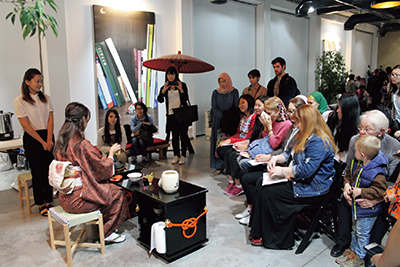 Tea ceremony lecture and demonstration (September 28 to October 1, Bishkek, Kyrgyzstan)
Tea ceremony lecture and demonstration (September 28 to October 1, Bishkek, Kyrgyzstan)Furthermore, MOFA conducts large-scale and comprehensive programs in commemorative years celebrating diplomatic events in cooperation with government and private organizations through mutual visits of dignitaries, various conferences, and public relations/cultural projects, with the aim of effectively promoting understanding about Japan. For example, a variety of events including a kyogen (traditional comic theater) performance by Mr. Nomura Mansaku and Mr. Nomura Mansai were held in 2018 to commemorate the 40th anniversary of the conclusion of the Treaty of Peace and Friendship between Japan and China.
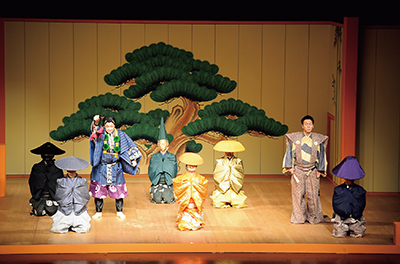 Kyogen performance to commemorate the 40th anniversary of the conclusion of the Treaty of Peace and Friendship between Japan and China (August 10, Beijing, China)
Kyogen performance to commemorate the 40th anniversary of the conclusion of the Treaty of Peace and Friendship between Japan and China (August 10, Beijing, China)In collaboration with MOFA and the diplomatic missions overseas, the JF runs two-way arts and cultural exchange projects to promote Japanese culture and arts in a variety of forms throughout the world. The JF also promotes and provides support for Japanese language education and research on Japan. When Yamato, a troupe of taiko (Japanese drum) players, gave a performance in a central square in Stockholm in August hosted by the JF and the Embassy of Japan in Sweden, the venue was filled with over 10,000 participants. It was a memorable event that added to the excitement of the 150th anniversary of the establishment of diplomatic relations between Japan and Sweden.
Furthermore, the Japan Foundation Asia Center has been steadily implementing the “WA Project: Toward Interactive Asia through Fusion and Harmony” announced by Prime Minister Abe in December 2013. The project consists of support for Japanese-language education and interactive arts and cultural exchange projects. Through the “NIHONGO (Japanese-language) Partners” program, which is the core project to support Japanese-language education, 1,855 (as planned) Japanese citizens were dispatched to educational institutions such as secondary school in ten countries in Southeast Asia, China, and Taiwan by the end of FY2018, in order to assist Japanese-language education. In addition, exchange programs were implemented to introduce Japanese culture. As a result, many overseas institutions working with the “NIHONGO Partners” appreciated their activities to enhance students' motivation for learning. For Japanese regional economies' revitalization based on the Government-Related Organization Relocation Basic Policy (March 2016), some trainings of this program took place at Ritsumeikan Asia Pacific University (Beppu City, Oita Prefecture).
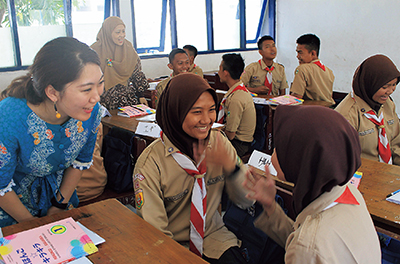 The “NIHONGO Partners” at their host institutions (September, Cirebon, Indonesia; Photo: The Japan Foundation)
The “NIHONGO Partners” at their host institutions (September, Cirebon, Indonesia; Photo: The Japan Foundation)In the two-way arts and cultural exchange program implemented by the Japan Foundation Asia Center, an international joint-production of DANCE DANCE ASIA connecting Asia through street dance, etc. was held for the area of performing arts. In the area of film, efforts were made to promote film exchange through collaboration with the Tokyo International Film Festival, and through the Japanese Film Festival (JFF): Asia-Pacific Gateway Initiative. In the area of sports, a soccer exchange program was held in collaboration with the Japan Football Association (JFA) and J-League, among other initiatives.
 DANCE DANCE ASIA-Crossing the Movements Tokyo Performance 2018 connecting Asia through street dance (March, Tokyo; Venue: Tokyo Metropolitan Theatre; Photography: Yosuke Kamiyama; Photo: The Japan Foundation)
DANCE DANCE ASIA-Crossing the Movements Tokyo Performance 2018 connecting Asia through street dance (March, Tokyo; Venue: Tokyo Metropolitan Theatre; Photography: Yosuke Kamiyama; Photo: The Japan Foundation)The Japan International MANGA Award was launched by MOFA in 2007 with the aim of rewarding manga creators who have contributed to the spread of manga culture overseas. The 12th International MANGA Award of 2018 received 331 entries from 68 countries and regions, and the Gold Award was given to a work from China. The number of applications was the highest ever including those from the countries that applied for the first time, namely Albania, Angola, Iraq, Uganda, Uzbekistan, Oman, and Turkmenistan.
To date, the Ministry of Foreign Affairs has strived to disseminate the manifold attractiveness of Japan through Japan's diplomatic missions overseas and the Japan Foundation, with the purpose of promoting better understanding of Japan and cultivating pro-Japanese groups and those with extensive knowledge of Japan. With soft power in diplomacy becoming increasingly important in recent years, there is a need for greater dissemination of Japanese culture, which is highly influential from a soft power perspective.
In light of that, for an approximately eight-month period starting from July 2018 that coincides with the 160th anniversary of the establishment of Japan-France diplomatic relations, “Japonismes 2018: les âmes en resonance (the Souls in Resonance)” was held in Paris and other parts of France. This event is intended to display all aspects of Japanese culture, ranging from traditional culture such as “Kabuki” (Japanese classical plays), “Noh” and “Kyogen” (traditional Japanese plays), and “Gagaku” (Japanese court music) to contemporary culture such as contemporary theater and art, “manga” and “anime” , and Japanese film, as well as everyday culture such as food, traditional crafts, and local festivals.
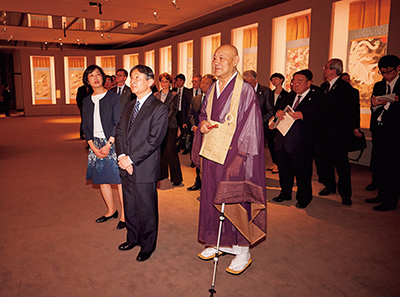 His Imperial Highness the Crown Prince at the Jakuchū exhibition
His Imperial Highness the Crown Prince at the Jakuchū exhibition©Pierre GROSBOIS 2018
The decision to implement this project was made in the “Beauty of Japan” Comprehensive Project Advisory Panel (chaired by Prime Minister Abe), based on the concept of harnessing the power of Japanese culture in diplomacy. “Japonismes 2018” was this century's largest project to introduce Japanese culture, and involved various relevant ministries led by the Ministry of Foreign Affairs, with the Japan Foundation serving as the secretariat, as well as the participation of private-sector corporations and other relevant parties. In addition to featuring Japanese culture, it is also characterized by the fact that it is an all-Japan project implemented through public-private cooperation with the aim of contributing to spreading the attractiveness of Japan's regions, promoting inbound tourism, and expanding the export of Japanese products overseas, while looking ahead to the Olympic and Paralympic Games Tokyo 2020.
Throughout the event period of “Japonismes 2018,” there were many opportunities for key persons from Japan to observe the various programs. Foreign Minister Kono attended the opening ceremony in July, and visited the “Au-delà des limites” exhibition presented by teamLab together with the Minister of Culture of France.
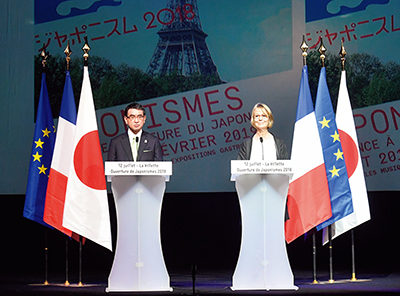 Opening ceremony of “Japonismes 2018”
Opening ceremony of “Japonismes 2018” Prime Minister Abe at the Jomon exhibition (Photo: Cabinet Public Relations Office)
Prime Minister Abe at the Jomon exhibition (Photo: Cabinet Public Relations Office)In September, His Imperial Highness the Crown Prince visited France to commemorate the 160th anniversary of friendly relations between Japan and France. During the visit, His Imperial Highness watched the “YUGEN” Noh x 3D image directed by Amon Miyamoto, together with French President Macron. His Imperial Highness also visited the “Jakuchū, Colorful Realm of Living Beings” exhibition, watched the “SHOCHIKU GRAND KABUKI” performance, and also attended the special light-up ceremony of the Eiffel Tower. His Imperial Highness' visit was widely covered by the media in France. Furthermore, Prime Minister Abe attended the “Jomon - Birth of art in prehistoric Japan” exhibition in October.
As of December 31, 2018, the number of participants and visitors for the various programs has exceeded 2.5 million people, and the event has provided an opportunity for many people in France and other countries to learn about Japanese culture. There are also plans to implement large-scale cultural projects in the United States and Southeast Asia in 2019. With a view to the Olympic and Paralympic Games Tokyo 2020, efforts will be made to promote cultural diplomacy while creating momentum for the Games from overseas.
Frederik L. Schodt
When I wrote the book, “Manga! Manga! The World of Japanese Comics” in 1983 to introduce Japanese manga culture to an English-speaking audience, I asked the late Dr. Osamu Tezuka, also known as the god of manga, to write the foreword. Re-reading it now, I am again deeply moved by Tezuka's foresight.
At a time when Japanese manga and anime culture had received little recognition by the West, Tezuka, while touching on the way Japanese books are read from right to left and language barriers, asserted that anime was “an excellent ambassador with incredible internationality.” He believed that once people became familiar with the nature of Japanese manga through anime, they would surely proceed to reading manga as well. He explicitly wrote, “I believe manga culture will keep spreading worldwide.”
Astro Boy, in 1963, was the first Japanese television anime series to be aired in the U.S., but at the time, children were not at all aware that it was from Japan. The situation greatly changed in the latter half of the 80s, and especially in the 90s, with anime and manga series such as Akira, Sailor Moon, Ghost in the Shell, and Pokémon (available in game form as well) becoming big hits. This success led to the substantial spread of Japanese manga and anime fandom across society. Today, like sushi, anime and manga are becoming part of American mass culture.
In the area of San Francisco where I live, not only at Kinokuniya Bookstore in the city, but even at ordinary comic book stores, there are many Japanese manga that have been translated into English. Although the age of DVDs has mostly ended, nowadays, anime that are subtitled or dubbed in English are aired on cable television or actively distributed online. The screening of long Japanese anime feature films at theatres is rare, but they can easily be watched on Amazon or Netflix. As far as films are concerned, it is also interesting that Hollywood film companies have begun to produce live-action films based on Japanese manga, such as Ghost in the Shell in 2017.
In the area of online distribution, the 2018 acquisition of Crunchyroll, an online distribution company for anime and manga formed in 2006, by AT&T, the world's largest telecom company, drew a great deal of attention. Even more interesting is the holding of anime and manga conventions in almost every large U.S. city, starting with the San Francisco area around 1990. In the summer of 2017, I participated in the annual East Coast event “Otakon” (an American-coined Japanese word that combines “otaku” and “convention”), and there were close to 30,000 people in attendance. In Los Angeles on the West Coast, some conventions attract 100,000 people. At these types of conventions, fans typically share information, purchase goods, form friendship networks, and, above all, enjoy cosplay.
In Japan, meanwhile, sometimes there are misleading articles that suggest Japanese manga and anime dominate the U.S. The reality is, however, that box office receipts for long CGI animation films made by Disney and Pixar are far larger than those for animated films by the popular Hayao Miyazaki. Japanese manga and anime are therefore still very much niche markets. And the market is even tougher for manga than anime. Sales actually peaked in 2007, before dropping sharply, and only now are the beginning to grow again.
However, popularity and influence cannot be measured solely by sales figures. The spread of Japanese manga and anime throughout the U.S. has exceeded what even Tezuka imagined. One might say this has been a fan-driven expansion. During the VHS era, fans often added their own subtitles and shared these with friends, but now, with the Internet, it is much easier to share things. Of course, this has also expedited the issue of the proliferation of pirated editions, and many fans have never purchased an authentic manga book. This is not a problem specific to the U.S. Fan groups take paper copies of the manga from Japan and scan them by themselves, then use software (such as Photoshop) to insert their own translations of speech, etc. This process is called “scan-lation,” a portmanteau combining the words “scan” and “translation,” and the resulting product is made freely available without permission. It is a true headache for many manga authors and publishers.
I am currently an executive committee member of the Japan International MANGA Award organized by the Ministry of Foreign Affairs. In recent years, there have been over 300 works submitted to the award from over 60 different countries, highlighting the influence of manga and anime as a true form of soft power. Looking at the winning works, nearly all have an individual style but are strongly inspired by Japanese manga and anime. It is something I am very happy to see.
Late 2018 in San Francisco
(Original in Japanese)
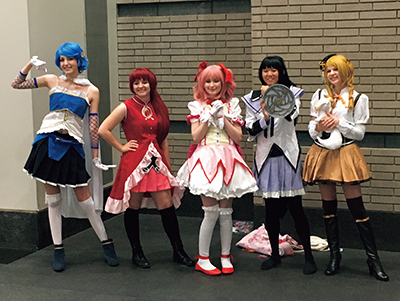
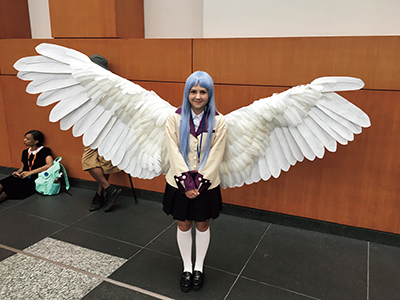 Young Americans enjoying cosplay at the 2017 Otakon convention.
Young Americans enjoying cosplay at the 2017 Otakon convention.©2018 Frederik L. Schodt
(3) People-to-People Exchange and Exchanges in the Area of Education and Sports
MOFA carries out a number of invitation projects to build personal connections and promote understanding of Japan by inviting foreign nationals who have a great influence on shaping public opinion and the policy making processes, and who are expected to play a leading role in various fields. Also, in the area of education and sports, MOFA carries out various activities to promote exchanges among a wide range of people. These projects not only promote mutual understanding and friendships but also enhance Japan's presence in the international community, which considerably benefits the national interest of Japan.
A Student Exchange Programs
MOFA actively introduces the attractiveness and opportunities of studying in Japan to foreign students through Japanese diplomatic missions overseas. It also implements application and screening procedures to grant competent students from around the world the Japanese Government (MEXT) Scholarship. It also makes efforts to network with former foreign students who have returned to their home countries through Japan Alumni Associations and to foster their further knowledge on Japan.
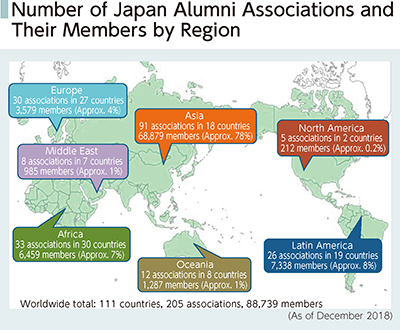
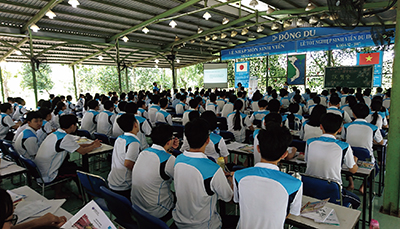 Briefing on studying in Japan at a Japanese language school (August 3, Ho Chi Minh City, Viet Nam)
Briefing on studying in Japan at a Japanese language school (August 3, Ho Chi Minh City, Viet Nam)B JET Programme (The Japan Exchange and Teaching Programme)
The JET Programme was launched in 1987 to improve foreign language education in Japan and promote international exchanges with Japanese citizens in local areas. In FY2018, a total of 5,528 people, including 2,201 new participants from 54 different countries, took part in the program and were dispatched all over Japan. This program is administered by local authorities, etc. in cooperation with the Ministry of Internal Affairs and Communications (MIC), MOFA, the Ministry of Education, Culture, Sports, Science and Technology (MEXT), and the Council of Local Authorities for International Relations (CLAIR). They invite young foreign nationals to Japan and appoint them to posts in local governments and schools. MOFA is responsible for the application and screening process, pre-departure orientation, and support for the activities of the JET Alumni Association (JETAA) in 18 countries with about 23,000 membership). JETAA and former JET participants conduct activities introducing Japan in many countries with their knowledge on the country making themselves valuable assets for Japan.
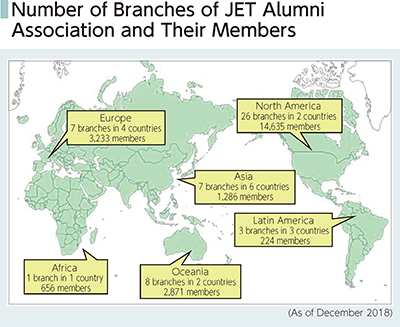
 JET participants prior to their departure for Japan (June, New Zealand; Embassy of Japan in New Zealand)
JET participants prior to their departure for Japan (June, New Zealand; Embassy of Japan in New Zealand)C Sport Exchange
Sports enable communication beyond languages and can be an effective tool for promoting friendly relations and understanding of Japan. While Japan draws attention from the world as the host country of the TOKYO 2020 Games, the Government of Japan has been implementing the “Sport for Tomorrow (SFT)” program as an international cooperation initiative through sports since January 2014. This program offers various sports exchanges, promotional support, and human development projects with the aim of spreading the value of sports among over 10 million people in more than 100 countries by 2020. SFT also includes the “Projects for Sports Diplomacy Enhancement” scheme, starting in FY2015, which is to dispatch and invite athletes and instructors, provide equipment, and hold sports-related receptions at diplomatic missions overseas. The projects have enabled MOFA respond even more promptly and meticulously to requests from the foreign governments and sports associations and develop bilateral relations. These SFT programs have contributed to enhance the presence of those engaged in sports in Japan in the international sports community.
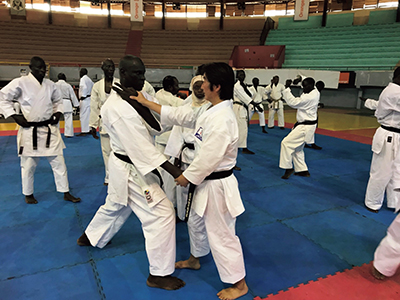 Participants learning karate from Japanese instructors (October, Senegal)
Participants learning karate from Japanese instructors (October, Senegal)
“Not once in four years. Once in a lifetime.”
This is the advertising slogan for Rugby World Cup 2019TM, Japan, which kicks off in September 2019. The global tournament for 15-player rugby held once every four years is one of the three largest global sporting events alongside the Olympic and Paralympic Games and the FIFA World Cup. Twenty teams, consisting of the top twelve teams (including Japan) from the previous tournament and eight teams that won the preliminary competitions, will compete fiercely for the shiny gold “Webb Ellis Cup” over a period of seven weeks in 12 cities across Japan, from Hokkaido to Kyushu.
Holding the Rugby World Cup in Japan is a historical event - it is the first in Asia, first in a non-traditional rugby country, and first since the selection of rugby (Sevens) as an event for the Summer Olympics.
Actor Hiroshi Tachi is serving as the “PR Captain” for the event. He is a rugby enthusiast who enjoyed playing it in his high school years. He won the Best Male Actor Award at the Montreal World Film Festival for his role in “Owatta Hito” (Life in Overtime) in September 2018. At an event immediately after the aforementioned film festival, which was held a year before Rugby World Cup 2019, the Rugby World Cup 2019 Organising Committee notably introduced Mr. Tachi as an actor in “Life in Overtime” who is just getting started in his role as “PR Captain.”

The Ministry of Foreign Affairs (MOFA) is conducting promotional activities worldwide, making maximum use of its diplomatic missions overseas around the world, to generate enthusiasm for the Rugby World Cup and encourage many foreign tourists to come to Japan in the autumn, a great time for sports. Some of these are as follows.
■Receptions at Ambassador's Residences
MOFA uses the residences of Japanese ambassadors to hold receptions for send-off events for national teams from other countries before their tour to Japan and for the Japanese national team when it goes on an overseas tour, as a means of fostering exchange with local representatives.
<Send-off event for the men's rugby representatives in Ireland>
Commemorating the 60th anniversary of the establishment of diplomatic ties between Japan and Ireland, MOFA invited members of the Irish national team and its staff to the ambassador's residence ahead of the Japan-Ireland men's rugby match in Japan.
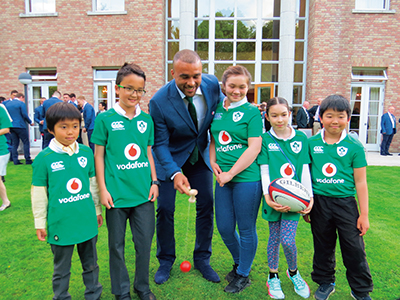 Irish national team players interacting with Japanese children living in Ireland
Irish national team players interacting with Japanese children living in Ireland(May 30, 2017, at the residence of the Japanese Ambassador to Ireland)
<Receptions for rugby-related personnel in Fiji and Nepal>
Japanese ambassadors in Fiji and Nepal held receptions on the occasion of the “Webb Ellis Cup” Rugby World Cup Trophy Tour. These events, in which the actual World Cup Trophy was displayed, were attended by local government representatives, as well as the head coach and players of the Fijian national team, and the vice president and other representatives of the Nepal Rugby Association.
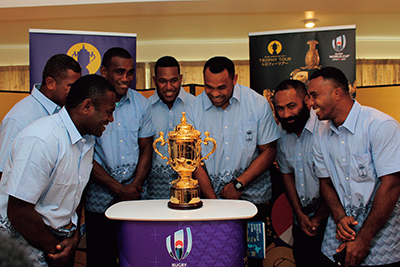 Fijian national players and the World Cup Trophy (May 21, 2018, at the residence of the Japanese Ambassador to Fiji)
Fijian national players and the World Cup Trophy (May 21, 2018, at the residence of the Japanese Ambassador to Fiji)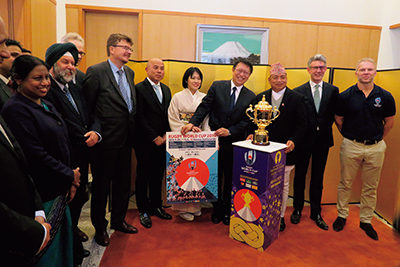 Standing around the World Cup Trophy at a reception on the previous Emperor's Birthday (December 7, 2018, at the residence of the Japanese Ambassador to Nepal)
Standing around the World Cup Trophy at a reception on the previous Emperor's Birthday (December 7, 2018, at the residence of the Japanese Ambassador to Nepal)<Reception for people associated with rugby sevens in San Francisco>
MOFA hosted a reception for the Japanese men's and women's national teams who were visiting San Francisco to play in the Rugby World Cup Sevens and local people involved with rugby.
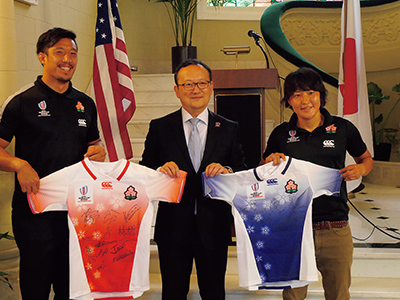 (July 17, 2018, at the residence of the Consulate General of Japan in San Francisco)
(July 17, 2018, at the residence of the Consulate General of Japan in San Francisco)■Utilization of Public Relations Materials at Diplomatic Missions Overseas
Working together with the Rugby World Cup 2019 Organising Committee, diplomatic missions overseas utilize videos, posters, pin badges, and other public relations materials created by the committee to actively promote the tournament at various local events.
Furthermore, diplomatic missions overseas help with confirming cooperation for Rugby World Cup 2019TM, Japan in summit meetings, foreign ministers' meetings, and other high-level government exchanges, arranging promotional booths at international conferences, and facilitating rugby exchanges with parliamentary members around the world.
Japan highly welcomes the holding of global sporting events such as Rugby World Cup 2019TM, Japan in various locations across Japan, which also promotes active people-to-people exchanges through sports and attracts a greater number of foreign tourists to Japan. The Olympic and Paralympic Games Tokyo 2020 will be also held in the following year. MOFA intends to make further efforts, while collaborating with public and private-sector representatives, to ensure that the many foreign tourists coming to Japan for Rugby World Cup 2019TM, Japan can enjoy smooth trips and return home with positive impressions of local areas in Japan.
The 2018 FIFA World Cup was held in various parts of Russia. Japan was mesmerized by the tremendous efforts made by the Japanese national football team, and football fans around the world were enthused by all the outstanding play at the tournament.
The success of such large-scale sports events requires cooperation and coordination by numerous officials, and the Ministry of Foreign Affairs (MOFA) also supports these events.
This column introduces initiatives taken by the Embassy of Japan in Russia as part of the safety measures for Japanese supporters and also looks at the connection between MOFA and sports events.
Preparation and response at temporary offices
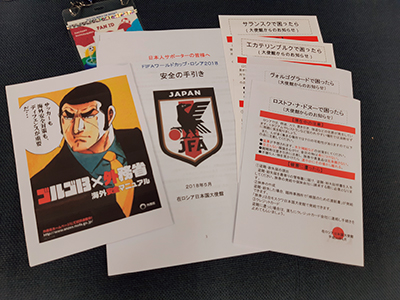 “Safety Guide”
“Safety Guide”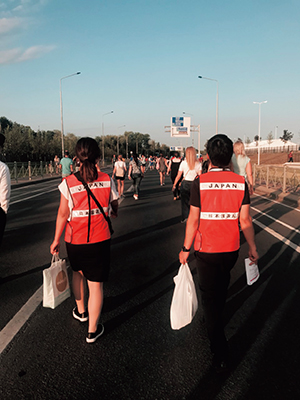 Distribution of “Safety Guide” by the Japanese Embassy in Russia
Distribution of “Safety Guide” by the Japanese Embassy in RussiaIt was expected that many Japanese supporters would come to watch the World Cup in Russia. Various measures were needed because some venues where the Japanese national team played were small cities which foreign tourists typically do not visit, and unexpected situations might also arise on a special occasion like the World Cup, such as soaring accommodation costs, extreme congestion of transportation facilities, and troubles with supporters from other countries.
For the 2018 FIFA World Cup, the Embassy of Japan in Russia created a “Safety Guide” to help Japanese supporters watch games with a sense of safety and enjoy a pleasant trip to Russia. In addition to information on public security and travel advisory on Russia, this guide also included a map of the area around game venues, contact information for the Japanese Embassy, a list of helpful Russian words in an emergency, and other information that is useful when watching a match or dealing with an incident. The Safety Guide was then uploaded on the Embassy's website. It was also distributed to Japan Football Association personnel and the media, as well as the areas around airports and stadiums.
Moreover, the Embassy closely exchanged information with the Russian government, police officials, and the embassies of other countries participating in the World Cup, while also setting up a temporary office of the Embassy at match venues before and after the Japanese national team's match day to assist Japanese supporters. Fortunately, no major incidents occurred, but there were inquiries about lost items and cases of theft, as well as an inquiry from someone who had been bitten by a dog and wanted to see a doctor, for which Embassy staff provided assistance by accompanying the person to the police and a hospital.
Japanese supporters at match venues
During the 2018 World Cup, Japanese supporters who visited the venues in Russia distributed hachimaki with a hinomaru design (bandanas with the Japanese flag) as a supporters' item both inside and outside stadiums to others who came to watch the games. At the World Cup, some spectators watch matches without having decided which team to cheer for in order to enjoy as many high-level games as possible, in addition to supporting their own country's team. Therefore, supporters who received the hachimaki would naturally end up supporting the Japanese national team. This scene, also broadcast in Japan, of spectators from other countries wearing the hachimaki and supporting the Japanese national team along with Japanese spectators left a deep impression. On the airplane traveling to a venue, there was an interaction between Japanese and Colombian supporters who could not verbally communicate to each other due to the language barrier, but they still got along very well and took commemorative photos together. This was a reminder of the value of sports that goes beyond the borders of countries.
Power of sports
Even though the Japanese national team regrettably lost in the first round of the knockout stages, Embassy staff walking around town were told by Colombian supporters that Japan had played a great match and overheard Russian people saying that Japan almost won. Meanwhile, news programs on Russian TV stations reported favorably on Japanese supporters cleaning up trash after the match. Coverage highlighted the Japanese national team's hard work and the good behavior of supporters. Japan lost, but sports spread a good image of the country to many people. This could be described as a form of diplomacy for showcasing Japan to other countries.
The success of the World Cup increased the number of people with a positive impression of Russia. Japan will hold the Rugby World Cup 2019TM, Japan and then the Olympic and Paralympic Games Tokyo 2020. People from all over the world will visit Japan to watch these major sports events. MOFA will utilize these opportunities to promote Japan's attractiveness.
(4) Exchange in the Intellectual Field
A Japanese Studies
The Japan Foundation (JF) comprehensively supports a range of overseas research activities related to Japan's politics, economics, society and culture. In 2018, the JF sent visiting professors, enhanced the collection of books on Japan, provided research grants, and provided support for seminars and symposiums, to the total of 73 institutions of Japanese studies in 31 countries and regions. Fellowship was also granted to 133 Japanese studies researchers in 40 countries and regions, including those who started the fellowship in the previous year. The JF also helps academic societies to networking among researchers and research institutions on Japan in many countries and regions.
B Intellectual Exchanges
MOFA puts emphasis on collaborative study and exchange with other countries and implements relevant projects through the Japan Foundation (JF). The JF helps implementation of seminars and symposia on common international agendas, and supports programs to deepen the understanding of contemporary Japan at major universities overseas. The JF also plans and supports exchange programs to strengthen relationships and mutual understanding among relevant parties through dialogue in various fields and levels in cooperation with NPOs and other exchange institutions.
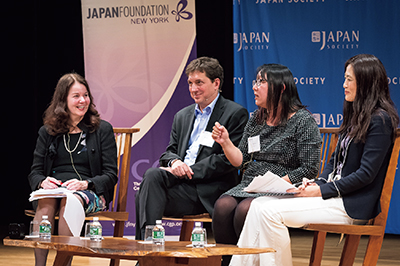 U.S-Japan Public Intellectuals Network Program (October, New York, U.S.; Photo: Alan Klein, Japan Society, The Japan Foundation)
U.S-Japan Public Intellectuals Network Program (October, New York, U.S.; Photo: Alan Klein, Japan Society, The Japan Foundation)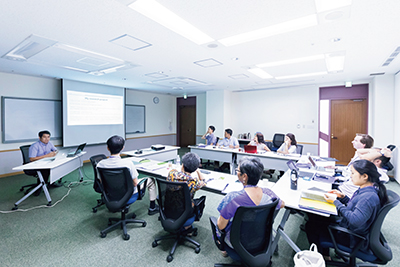 Forming Japan-U.S.-Southeast Asian Networks Summer Institute (July, Japan; Photo: The Japan Foundation)
Forming Japan-U.S.-Southeast Asian Networks Summer Institute (July, Japan; Photo: The Japan Foundation)C Japan-U.S. Conference on Cultural and Educational Interchange (CULCON)
CULCON is a public-private binational advisory panel comprised of experts from Japan and the U.S. to discuss issues on educational and cultural exchanges between the two countries. In June 2018 the 28th Plenary Meeting was held in Washington DC (U.S.). At the start of the meeting, messages from Prime Minister Abe and U.S. President Trump were read out, and then consultations were held on the initiative and future measures of the Arts Dialogue Committee, the Education Review Committee, the Japanese Language Education Committee and the Next Generation Task Force. The Joint Statement issued as the outcome of the meeting confirmed the progress of the initiatives taken by Japan and the U.S. toward achieving the goal of “doubling two-way student exchanges by the year 2020” which was also mentioned in the Joint Statement at the Japan-U.S. Summit Meeting in 2014. Other recommendations in the Joint Statement were about the importance of building a new platform for nurturing the next generation of leaders who will be responsible for Japan-U.S. relations, the latest outcomes and the continuation of activities in arts exchange, the measures for enhancing Japanese language education in the U.S. and further revitalization of student exchanges between the two countries.
D Cooperation with the United Nations University (UNU)
Recognizing the importance of the UNU, which contributes to the international community through study and research on global issues and human resources development. Japan invited the UNU headquarters in Japan (Tokyo), which has provided various cooperation and support for the last 40 years since its establishment. The UNU, in collaboration with Japanese universities and research institutions, is engaged in studies on international issues on which Japan focuses, including peace, development, and the environment, consequently contributing to the introduction of the policies of the Government of Japan. The UNU established Master's and Doctoral Programmes in 2010 and 2012 respectively, and has made efforts to improve the quality of its global human resources development programs.
(5) Promotion of the Japanese-Language
Against the background of the globalization of Japanese companies and the popularity among Japanese pop culture, there has been growing interest in the Japanese-language in the world, especially among the youth. A better understanding in the Japanese-language overseas naturally leads to a favorable international environment and setting for Japanese people and companies. Based on a survey conducted by the JF in FY2015, approximately 3.66 million people in 137 countries and regions overseas learn the Japanese-language. In 2018, the Japanese-Language Proficiency Test offered by the JF was conducted in 296 cities of 86 countries and regions worldwide, and the number of applicants reached about 1.17 million, the highest figure (include applicants taking the test in Japan). On the other hand, it is clear that a shortage of Japanese-language instructors presents a grave challenge to respond to the interests and needs of the studies in many countries and regions.
MOFA works to deal with the diverse needs related to Japanese-language education overseas through the JF. For example, it dispatches Japanese-language specialists abroad, conducts invitation programs for Japanese-language instructors and foreign diplomats to learn the language in Japan, conducts preparatory Japanese-language pre-arrival training for nurse and care worker candidates based on the Economic Partnership Agreement (EPA) with Indonesia and the Philippines, encourages educational institutions in each country and region to introduce Japanese-language education and supports their Japanese-language educational activities, develops teaching materials, operates e-learning, and promotes the “JF Standard for Japanese-Language Education” that corresponds with international standards for foreign language education. As a result of these efforts, a growing number of countries are newly introducing Japanese-language education as a part of the school curriculum in recent years. For example, Japanese-language education has been introduced as a part of secondary education in Laos in 2015, and primary education in Viet Nam in 2016. In the UK, elementary schools offering Japanese language learning expanded from about 50 schools in 2014 to more than 100 schools in 2017. At the Japan-India Summit Meeting in September 2017, the both countries agreed to cooperate on expanding Japanese-language education at universities and other institutions in India. The Japanese-Language Teachers' Training Center was established in Delhi in July 2018 and new training courses were commenced. In addition, new training courses, as initiatives for Japanese-language teachers' training, were offered in Viet Nam and Myanmar in December the same year.
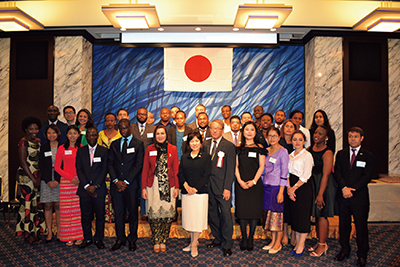 State Minister for Foreign Affairs Toshiko Abe attending the welcome reception for the participants in the 38th Japanese language training for diplomats and 22nd Japanese language training for public servants (October, Tokyo) (Middle: the State Minister)
State Minister for Foreign Affairs Toshiko Abe attending the welcome reception for the participants in the 38th Japanese language training for diplomats and 22nd Japanese language training for public servants (October, Tokyo) (Middle: the State Minister)(6) Cultural Grant Assistance
The Government of Japan provides Cultural Grant Assistance, as part of Official Development Assistance (ODA) to promote culture and higher education in developing countries, thereby enhancing mutual understanding and friendly relations between Japan and such countries. The assistance implemented in 2018 included four Cultural Grant Assistance projects (total of around 1.61 billion Japanese yen) and 21 Grant Assistance for Cultural Grassroots Projects (total of around 180 million Japanese yen). In 2018, Cultural Grant Assistance was implemented with the emphasis on sports promotion, the preservation of the cultural heritage and the broadcasting sector, while Grant Assistance for Cultural Grassroots Projects put emphasis on cooperation in the fields of sports promotion and the Japanese language.
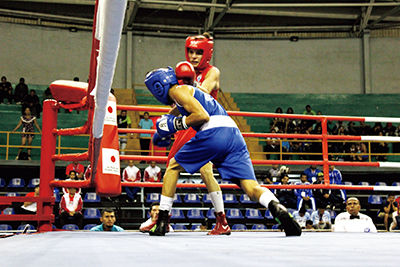 The Central America Boxing Championship held using the ring provided to the Costa Rican Boxing Association through Grant Assistance for Cultural Grassroots Projects (October 30, Costa Rica)
The Central America Boxing Championship held using the ring provided to the Costa Rican Boxing Association through Grant Assistance for Cultural Grassroots Projects (October 30, Costa Rica)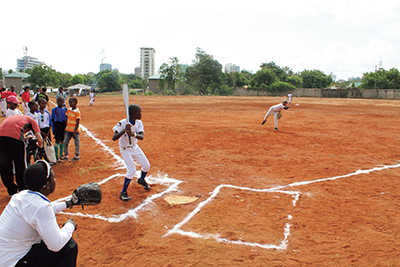 Baseball experience event involving local elementary school students held on a baseball field developed through Grant Assistance for Cultural Grassroots Projects (December 6, Tanzania)
Baseball experience event involving local elementary school students held on a baseball field developed through Grant Assistance for Cultural Grassroots Projects (December 6, Tanzania)(7) Cooperation through United Nations Educational, Scientific and Cultural Organization (UNESCO)
Japan is actively involved in various projects of UNESCO in the fields of education, science, and culture. UNESCO is the international organization of which post-war Japan first became a Member State in 1951. Since then, UNESCO has been cooperating with Japan in support of education, science, culture, etc., in developing countries.
In the field of culture, Japan offers active cooperation for the prevention and promotion of tangible and intangible cultural heritage of the world and support in the field of human resources development. At the same time, Japan actively participates in the international framework for safeguarding cultural heritage. As a part of such activities, Japan provides voluntary contributions to UNESCO aimed at the protection of tangible and intangible cultural heritage. Using a part of these contributions, and with Japanese experts playing a leading role, Japan supports many projects for conservation and restoration of sites, such as Angkor in Cambodia, and Kasubi Tombs in Uganda, while contributing to human resources development so that local people can protect their cultural heritage by themselves in the future. In particular, Japan provides continuous support for the preservation and restoration work of the ancient ruins of Angkor in Cambodia, which started in 1994. With regard to the safeguarding of intangible cultural heritage, the following projects have been implemented: the handing down of traditional performing arts such as music and dance, and traditional crafts in developing countries to the next generation; development of domestic institutions and capacity building of relevant parties to enhance the ability of countries to protect intangible cultural heritage by themselves.
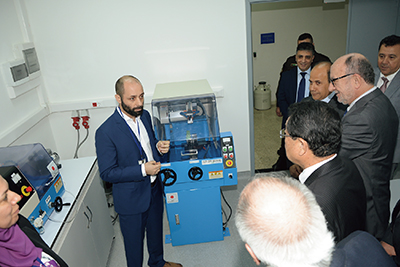 Archeological research equipment provided to the National Council for Scientific Research through Cultural Grant Assistance (November, Lebanon)
Archeological research equipment provided to the National Council for Scientific Research through Cultural Grant Assistance (November, Lebanon)In the field of education, Japan provides voluntary contributions with the aim of fostering human resources in developing countries. It also provides support for human resources development, mainly in the area of education, through promoting, for example, “SDG4-Education 2030” led by UNESCO. As for the Education for Sustainable Development (ESD), in response to the fact that the “Global Action Programme (GAP) on ESD,” an international ESD promotion program, was due to end in 2019, at the April 2018 meeting of the Executive Board of UNESCO Japan presented a draft GAP successor framework and proposed to UNESCO a resolution calling for submission of the framework to the spring Executive Board of UNESCO in 2019, and the resolution was adopted. In October, three organizations from Namibia, Indonesia and Estonia were awarded the fourth UNESCO-Japan Prize on Education for Sustainable Development.
Africa is another field that UNESCO is investing its effort. Japan's support for Africa includes implementation of a project to promote peacebuilding and social stabilization through the training of teachers in Eritrea, Ethiopia, Kenya, Somalia, South Sudan and Uganda (ended in June 2018) and projects for peacebuilding and the prevention of extremism through education for teachers in Algeria, Ethiopia, Cameroon, Sudan, Senegal, Chad, the Central African Republic, Burkina Faso, Nigeria, Niger, Mali, and Mauritania.
UNESCO is promoting its organizational reforms, decentralization and program reforms, and Japan has continued providing support to UNESCO in these reform initiatives. In October, Prime Minister Abe received a courtesy call by Director-General of UNESCO Azoulay, during his visit to Paris. In the meeting, Director-General Azoulay stated that she wished to cooperate further with Japan in areas including the UNESCO's strategic transformation, gender equality, ESD, the initiative on the ethics of artificial intelligence (AI), the “Revive the Spirit of Mosul” (in northern Iraq) initiative and DRR (disaster risk reduction). In response, Prime Minister Abe expressed that Japan would cooperate with UNESCO's efforts and the ongoing reform of UNESCO toward the goal of its de-politicization.
A World Heritage Convention
The World Heritage Convention aims to protect cultural heritages and natural heritages internationally as heritages to all of mankind. Japan became a party to the Convention in 1992 (as of December 2018, the number of parties to the Convention is 193). The sites listed on the “World Heritage List” are so-called “World Heritage” sites. They are classified into “Cultural Heritage” (monuments and remains), “Natural Heritage” (natural areas) and “Mixed Heritage” (having both cultural and natural elements). As of December 2018, a total of 1,092 World Heritage sites are inscribed on the World Heritage List. At the 42nd session of the World Heritage Committee held in Manama, Bahrain, in 2018, it was decided to inscribe the Hidden Christian Sites in the Nagasaki Region (Nagasaki and Kumamoto), upon nomination by Japan, on the World Heritage List. This has raised a number of World Heritage sites in Japan to 22: 18 cultural heritage sites and four natural heritage sites.
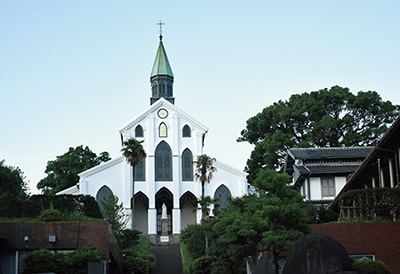 Oura Cathedral (One of the assets comprising the “Hidden Christian Sites in the Nagasaki Region”) (Photo: Nagasaki Prefecture; Photography: Mr. Tsutomu Ikeda)
Oura Cathedral (One of the assets comprising the “Hidden Christian Sites in the Nagasaki Region”) (Photo: Nagasaki Prefecture; Photography: Mr. Tsutomu Ikeda)B Convention for the Safeguarding of the Intangible Cultural Heritage
The Convention for the Safeguarding of the Intangible Cultural Heritage aims to develop an international system for safeguarding intangible cultural heritage, such as traditional performing arts and traditional craftsmanship techniques (as of December 2018, the number of parties to the convention is 178). Japan, which has a wealth of experience in safeguarding domestic intangible cultural properties, has contributed actively by taking on a leading role in developing the Convention, laying down the main sections of the operational directives for the implementation of the Convention. As of December 2018, a total of 21 elements of intangible cultural heritage in Japan are inscribed on the Representative List of the Intangible Cultural Heritage of Humanity established in accordance with the Convention. These include: Nogaku Theatre, Ningyo Johruri Bunraku Puppet Theatre and Kabuki Theatre, which have been proclaimed by UNESCO as “Masterpieces of the Oral and Intangible Heritage of Humanity.” In 2018 the 13th Session of the Intergovernmental Committee for the Safeguarding of the Intangible Cultural Heritage held in Port Louis, Mauritius, decided on inscription of “Raiho-shin, ritual visits of deities in masks and costumes,” which was nominated by Japan, on the list of intangible cultural heritage of Japan.
C UNESCO Memory of the World Programme
The UNESCO Memory of the World Programme was established in 1992 to preserve and promote valuable historical documents. As of December 2018, 427 items have been inscribed.
The fact that submission and inscription of nominations is done based only on the assertions of one country, despite there being clear discrepancies between the views of the countries involved, is in violation of the founding principle of UNESCO of promoting friendly ties and mutual understanding among member countries. Therefore, improvement of the review process is being advanced. At the Executive Board of UNESCO held in October 2018, a revised action plan concerning the comprehensive review process was adopted. Thereafter, discussions toward improvement of the process based on the plan were held.




